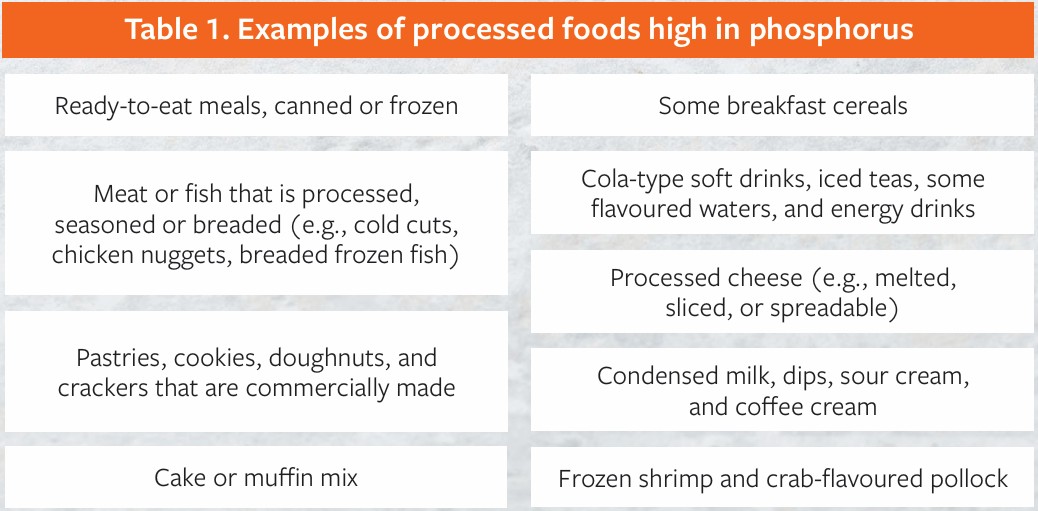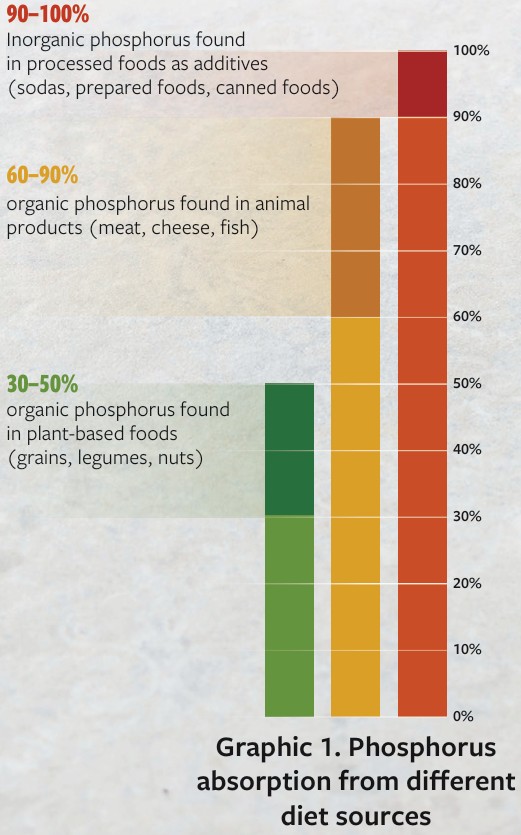Phosphorus Revisited

By Stéphanie Pasaman Dt.P.
One of the key dietary recommendations for people with chronic kidney disease is limiting phosphorus intake. It is still necessary for most patients, but the guidelines on the restriction of phosphorus have changed. For example, people on dialysis were told to limit their phosphorus intake to 800–1000 mg per day. This often meant reducing dairy products to 1 portion per day, and avoiding certain foods considered very rich in phosphorus like nuts, legumes, and whole grains. However, current research shows that differences in phosphorus absorption from different types of food allow a more flexible approach to dietary recommendations.
Phosphorus comes in different forms
One of the key changes is the focus on the type of phosphorus consumed. Phosphorus exists in both organic and inorganic forms; these forms differ significantly in how the body absorbs them.
• Organic phosphorus is found in meats, dairy products, legumes, and grains. It is naturally occurring and generally less bioavailable (which means it is absorbed at lower rates).
• Inorganic phosphorus is found in food additives and processed foods and is highly bioavailable (absorbed at higher rates). See Table 1

Quantity — but also quality — matters
Recent studies show that at least 90% of phosphorus from additives is absorbed by the body compared to as little as 30% from natural foods. This is why processed foods and fast foods have been linked to causing high blood phosphorus levels in people with kidney disease. See graphic 1
So—the current guidelines focus more on the quality and source of phosphorus rather than quantity alone. Limiting processed foods containing phosphorus additives is an effective strategy to lowering phosphorus levels, as is enjoying nutrient-dense whole foods that contain naturally occurring phosphorus.
One step you can take to reduce your intake of inorganic phosphorus is to check the list of ingredients on food labels and avoid foods that contain phosphorus additives. Look out for the words “phosph“, e.g., potassium phosphate, phosphoric acid, trisodium phosphate, etc.).

The benefits of plant-based eating
Recent recommendations also explore the possible benefits of eating more plant-based foods for managing phosphorus levels. In fact, plant-based sources of phosphorus (like beans, nuts, and whole grains) are the least efficiently absorbed.
This approach can offer additional health benefits beyond managing your phosphorus intake. In fact, choosing plant-based foods more often will increase your intake of fibre and antioxidants. It also reduces your intake of saturated fats, which may help reduce cardiovascular risk—a major concern for people with chronic kidney disease. Eating more plant-based foods can also help control diabetes and promote weight loss.
Some plant-based foods can be lower in protein, so it is important to be sure of adequate protein intake for people on dialysis because protein is essential for maintaining muscle mass and overall health. If you wish to follow a more plant-based diet, your dietitian can help you balance phosphorus restriction with this need for the right amount of protein.
What to remember
•Limit your phosphorus intake and focus on eliminating phosphorus additives. Read food labels and avoid processed foods. See Table 1
•Choose more plant-based foods such as fruits, vegetables, legumes, nuts, seeds, and tofu to help control the level of phosphorus in the blood. This will promote heart health, improve diabetes control, and help with weight management.
• If you follow a plant-based diet and are on dialysis, make sure you are getting enough protein.
•Speak with your dietitian if you have any questions about phosphorus.

